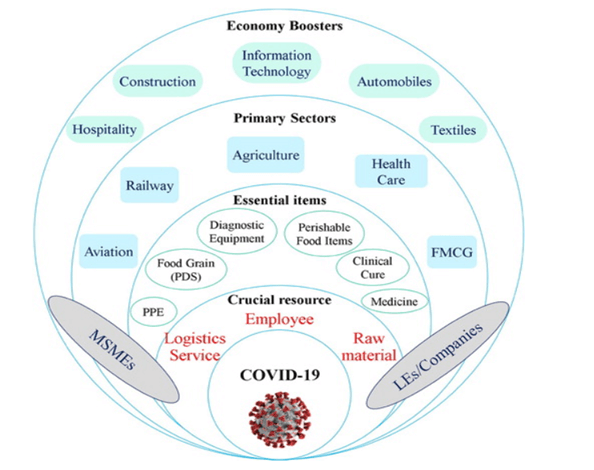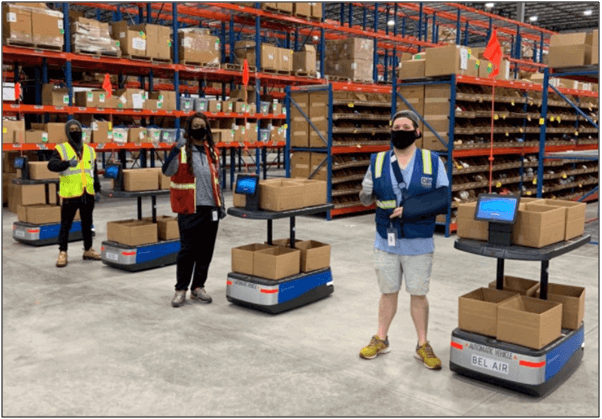The emergence of Covid-19 has made a huge impact to human and worldwide economics, bringing not only serious unforeseen negative impacts but also the forces to a change towards a “new normal”. The loss and fallout from the pandemic are increasingly clear, while its ending is not within sight.
Many sectors are experiencing difficulties and challenges in order to survive, overcome and living together with the pandemic. One such sector is logistics, where essential factors such as transport and goods are being affected by preventive measures against the pandemic, but are in great demand during peak seasons.

In order to be better prepared for a recovery plan in the current uncertainty, there are five key steps that would requires firms to undertake:
- Identify and assess potential impacts of the pandemic to logistics and business scopes in both short term and long term
- Identify the essential elements for resumption and recovery
- Assess available resources of logistics and business, understand their capabilities and limitations
- Plan the required actions, timeline and targets for resumption and recovery
- Implement, monitor and control the recovery progress and status
Table of Contents
Identifying and Assessing the Impacts
The impact of Covid-19 pandemic has been amplified in many aspects, such as economics, politics, society, business strategies and operations. An extensive view on existing and potential impacts is important to efficiently plan for various crisis scenarios. Manpower is a key driver of the logistics sector, as they transport goods from place to place. The pandemic affects manpower directly, where movement restrictions are imposed such as border lockdowns, social distancing, telecommuting, leading to a drop in logistical capacity in the near term. As the pandemic is spread by human beings, it creates a domino effect of reduced travel demand (and thus, the amount of cargo that can be transported in passenger flights), decreased productivity in logistics and business systems, shortage of containers and transportation options. This will lead to longer travel times for goods to get from the origin to its destination and at higher logistics costs. In addition to regularly updated information on official and reliable channels (such as governments, news and media outlets), enterprises must closely monitor and measure the indicators (e.g. operational performance, delivery reliability, cost to budget), in order to promptly identify the influencing factors and have proper assessment about level, duration and range of their impact.

Identifying Essential Elements for Recovery
A recovery plan for the industry is vital in this pandemic and thus, identifying the key drivers will help its swift recovery. The logistics system structure, availability of transportation, automation of certain processes and procedures, government assistance and inclusivity of the international community are the key factors affecting the recovery plan. This pandemic has also shown how important automation is to ensure logistics continuity and also to mitigate the impact brought about by the absence of people during lockdowns. Automation supports to facilitate efficient safe distancing measures, contact tracing, enables digital applications and contactless operations. In the digital era of, e-commerce websites have seen a great boost in online purchases or transactions brought about from the side effects of the pandemic, travel restrictions and various degrees of lockdowns in many countries. This further amplifies the importance for sale logistics, especially for order fulfillment.
A company which does not have adequate automation processes is less able to adapt to changes in an event if there is a sudden surge in demand, especially when the e-commerce marketplace has gone global. The supporting infrastructure for automation would also need to be in place for it to be operationalized efficiently, such as backend IT systems, network security and support services. Other critical factors are alternative supply resources, and not just the supply of goods and services, but also supply of manpower, are also important. In logistics, this would mean the resources for service providers/ partners, delivery routes, skilled local workforce, vendors of handling equipment and technology.

Assessing Available Resources
Resources of enterprises can come from internally and externally. This includes financial resources (e.g. budget, cash flow), inventory, infrastructure, manpower, business partners and processes in places. The capability and restrictions of available resources, especially of critical factors, will decide the direction, action plan and goals towards appropriate recovery plans, where the resource allocation is likely to be based on the priority and its purpose. It is important for companies to re-evaluate their available resources through a SWOT analysis. This will help to identify opportunities in this pandemic and be better positioned for recovery. For cases where there are gaps between current and required resources are identified, there is a need for addition, rearrangement or improvement to enhance their recovery timeline.
The full content is only visible to SIPMM members
Already a member? Please Login to continue reading.
References
Kirti Ratan Umralkar, DLSM (2020). “The implications of Covid-19 on Logistics Transportation”. Retrieved from SIPMM: https://publication.sipmm.edu.sg/the-implications-covid-19-logistics-transportation/, accessed 08/12/2020.
Jeremy Ng, DPSM (2020). “Key Considerations for Hotel Procurement Post Covid-19”. Retrieved from SIPMM: https://publication.sipmm.edu.sg/key-considerations-for-hotel-procurement-post-covid-19/, accessed 12/12/2020.
Lee Meng Yin, DPSM (2020). “Mitigating Global Sourcing Risks in a Pandemic”. Retrieved from SIPMM: https://publication.sipmm.edu.sg/mitigating-global-sourcing-risks-in-a-pandemic/, accessed 12/12/2020.
Ulrich Koegler, et.al. (2020). “Recovery plan for logistics companies in the GCC”. Retrieved from https://www.strategyand.pwc.com/m1/en/articles/2020/recovery-plan-for-logistics-companies-covid19.html, accessed 08/12/2020.
Harsha Basnayake, et.a. (2020). “Covid-19 Business continuity plan: Five ways to reshape”. Retrieved from https://www.ey.com/en_gl/strategy-transactions/companies-can-reshape-results-and-plan-for-covid-19-recovery, accessed 08/12/2020.
Jim Hall. (2020). “How to build a disaster recovery plan: 7 tips”. Retrieved from https://enterprisersproject.com/article/2020/9/disaster-recovery-how-create-plan, accessed 08/12/2020.
Sarah Banks, et.al. (2020). “Freight and Logistics providers leading the supply chain recovery”. Retrieved from: https://www.accenture.com/sg-en/insights/industrial/coronavirus-freight-logistics-recovery, accessed 13/12/2020.
Camelot Management Consultants. (2020). “Covid-19: Taking the first steps to Recovery”. Retrieved from https://www.controlrisks.com/covid-19/covid-19-taking-the-first-steps-to-recovery, accessed 19/12/2020.

